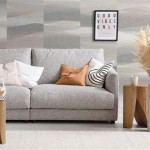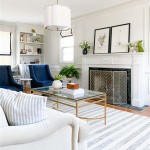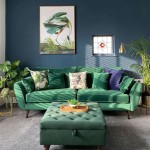How to Arrange a Large Living Room: Maximizing Space and Comfort
Arranging a large living room presents a unique set of challenges and opportunities. The sheer scale of the space can feel overwhelming, potentially leading to a room that feels empty, disjointed, and lacking in warmth. However, with careful planning and consideration, a large living room can be transformed into a welcoming and functional area that serves as the heart of the home. This article explores essential strategies for effectively arranging a large living room, focusing on key principles to maximize space, create cohesive zones, and ensure comfortable living.
Define Zones and Functions
The first and most crucial step in arranging a large living room is to define the distinct zones within the space. A large living room can often accommodate multiple functions, and clearly designating these functions with specific furniture arrangements is essential for creating a sense of order and purpose. Consider the primary activities that will take place in the room. Will it primarily be a space for relaxing and watching television? Will it serve as a gathering area for entertaining guests? Or will it incorporate elements of both, along with perhaps a reading nook or a home office area?
Once the desired functions are identified, it becomes possible to strategically allocate space for each zone. For example, a dedicated seating area focused on a television or fireplace can serve as the primary relaxation zone. This area might include a large sectional sofa, comfortable armchairs, and a coffee table. A separate seating area with smaller chairs and a side table can create a more intimate conversation zone. If space allows, a desk and chair can be incorporated into a corner of the room to create a functional home office area. A bookcase and comfortable armchair can define a reading nook.
Visual cues can be used to further delineate these zones. Area rugs are particularly effective in defining individual spaces within a larger room. A large rug under the main seating area will anchor the furniture and visually separate it from other areas. Changes in flooring, such as transitioning from hardwood to carpet or tile, can also create subtle divisions. Strategic placement of furniture, such as using a sofa as a room divider, can further enhance the separation between zones. The key is to create a sense of distinctiveness for each area while maintaining a cohesive overall design.
Scale and Proportion: Choosing the Right Furniture
In a large living room, standard-sized furniture often appears dwarfed, leading to an unbalanced and underwhelming aesthetic. Selecting furniture that is appropriately scaled to the space is crucial for creating a sense of visual harmony. Consider opting for larger pieces of furniture that can adequately fill the room without feeling cramped. A large sectional sofa, for example, can provide ample seating and visually anchor the main seating area. Oversized armchairs and substantial coffee tables can also contribute to a more balanced and proportionate look.
The height of the furniture is equally important. Low-slung furniture can get lost in a large space, while taller pieces can create a more visually impactful presence. Consider incorporating a mix of heights to add visual interest and prevent the room from feeling monotonous. Tall bookshelves, floor lamps, and artwork can all contribute to a more dynamic and engaging space. When selecting artwork, choose pieces that are appropriately sized for the walls. Small artwork can appear insignificant in a large room, so consider opting for larger pieces that can make a statement.
When arranging the furniture, pay attention to the spacing between pieces. Ensure that there is enough room to comfortably navigate around the furniture without feeling cramped. Avoid pushing all the furniture against the walls, as this can make the room feel even larger and less inviting. Instead, create natural pathways and allow for some breathing room between furniture pieces. A well-arranged space will feel comfortable and inviting, encouraging people to relax and socialize.
Creating Visual Interest and Cohesion
A large living room can easily feel impersonal and sterile if it lacks visual interest and a cohesive design scheme. Incorporating a variety of textures, patterns, and colors is essential for creating a warm and inviting atmosphere. Consider layering different textures, such as incorporating plush rugs, soft throws, and textured pillows. Playing with patterns can also add visual interest, but it's important to do so in a balanced and intentional way. Avoid overwhelming the space with too many competing patterns. Instead, choose a few key patterns and use them sparingly throughout the room.
Color plays a crucial role in creating a cohesive design scheme. Choose a color palette that reflects the desired mood and atmosphere. Light and airy colors can make a large room feel more spacious and inviting, while darker colors can create a more intimate and cozy feel. Consider using accent colors to add pops of visual interest. Accent colors can be incorporated through artwork, accessories, and small furniture pieces. The key is to choose colors that complement each other and create a sense of harmony.
Accessorizing the room is the final step in creating a cohesive and visually appealing space. Choose accessories that reflect personal style and interests. Incorporate artwork, decorative objects, and plants to add personality and warmth. Consider using mirrors to reflect light and create the illusion of more space. Carefully curate the accessories to avoid cluttering the room. The goal is to create a space that feels both stylish and comfortable.
Lighting is another critical element in creating visual interest and a welcoming ambiance. A combination of ambient, task, and accent lighting is essential for creating a well-lit and functional space. Ambient lighting provides overall illumination, task lighting provides focused light for specific tasks, and accent lighting highlights architectural features or artwork. Consider using dimmer switches to control the intensity of the lighting and create different moods. Well-placed lighting can transform a large living room from a cold and impersonal space into a warm and inviting haven.
Ultimately, arranging a large living room is about creating a space that is both functional and aesthetically pleasing. By carefully defining zones, selecting appropriately scaled furniture, and incorporating visual interest and cohesion, it is possible to transform a large living room into a comfortable and inviting space that meets the needs of its occupants.

10 Tips For Styling Large Living Rooms Other Awkward Spaces The Inspired Room

10 Tips For Styling Large Living Rooms Other Awkward Spaces The Inspired Room

Reader Question How To Arrange A Large Living Room Stauffer Design Co An Interior Company

10 Tips For Styling Large Living Rooms Other Awkward Spaces The Inspired Room

10 Tips For Styling Large Living Rooms Other Awkward Spaces The Inspired Room

Large Living Room Ideas Practical Solutions For Big Spaces Decorilla Online Interior Design

How To Arrange Furniture In A Large Living Room

How To Arrange Furniture In A Long Living Room Setting For Four Interiors

How To Arrange Furniture In A Long Living Room 2025 Grace My Space

5 Tips And Tricks For Arranging Your Living Room Furniture Khf Blog








